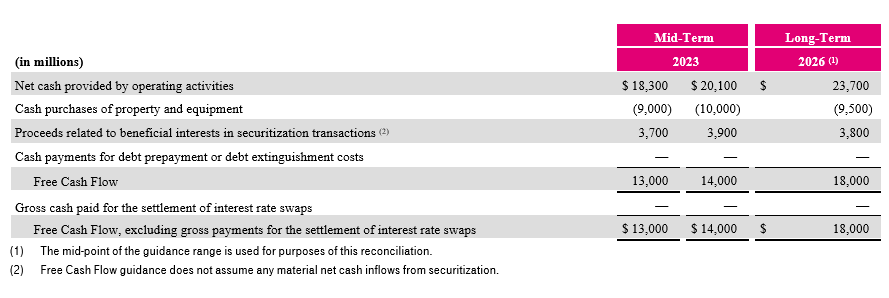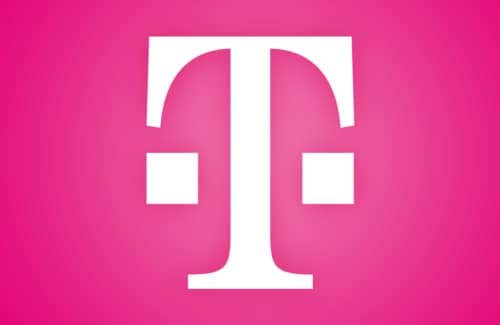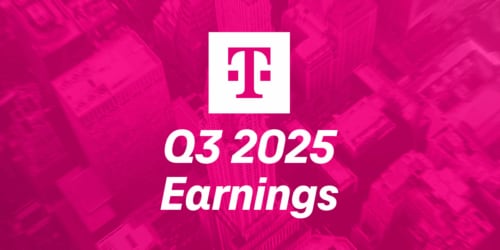BELLEVUE, Wash. – March 11, 2021 – In its virtual Analyst Day today, T-Mobile US, Inc. (NASDAQ: TMUS) unveiled ambitious plans to unlock future growth and capture even more momentum over the next five years. Since closing its historic merger with Sprint in April 2020, the Supercharged Un-carrier has delivered industry best total net additions, strong profitability and higher than expected synergies, putting the company on the path to deliver financial results that exceed both the original three to four-year and longer-term targets provided in the original merger plans.
Through a line-up of some of the company’s senior executives today, the Un-carrier outlined plans to use its combination of superior assets and scale from the merger and the recent C-Band auction, to continue leading the industry in growth by delivering more value AND the best 5G network combined with the best experiences to consumers and businesses across the country.
“Only T-Mobile has the superior assets, scale, financial position and customer-loving team to lead this new 5G era now into the next decade, if not beyond. We are taking that lead and setting our sights higher — taking on new growth ambitions and expanding into new markets like never before. We’re already miles ahead in executing on our clear and consistent plan, building the fastest, biggest and most available 5G network with the perfect mix of spectrum. That is going to continue to translate into a significant and demonstrable advantage for years to come,” said T-Mobile CEO Mike Sievert.
“Better yet, this network and growth is primarily funded by our massive synergies. I am incredibly proud of our team for driving faster integration and unlocking even more synergies than expected, which will deliver incredible value for our customers and shareholders,” Sievert continued. “We now expect the total net present value of merger synergies to be more than $70 billion — a 60 percent jump from our original merger plan. We’ve also raised mid- and long-term guidance, setting up the potential to return up to $60 billion to shareholders between 2023 and 2025. The next chapter for this Un-carrier is tremendously exciting – and we are truly just hitting our stride!”
Key Event Themes
- Positioned to Maintain 5G Leadership in the 5G Era – T-Mobile’s fastest, biggest and most available 5G network is the foundation on which all of the company’s short- and long-term goals are built. The Un-Carrier’s superior assets and unrivaled ability to execute has already put the company in the leadership position for 5G and it will continue to drive toward a demonstrable and sustainable 5G leadership advantage that is expected to last throughout the 5G era and beyond.
- C-band Enhances T-Mobile’s Positioning – While its competitors spent unprecedented totals on the C-band auction, T-Mobile invested within its financial plan in C-band to add to its Ultra Capacity 5G. While its Ultra Capacity 5G will have the broadest reach and capacity, T-Mobile added C-band concentrated on suburban and urban areas, where it will make the biggest impact. This ensures mid-band superiority for the 5G era when it comes to quantity, reach and deployment costs. Securing 40 MHz of spectrum in top markets will augment and complement T-Mobile’s premier, multi-layer spectrum portfolio, positioning the company for continued leadership and to provide the best customer experience through the 5G era.
- Building the Fastest, Biggest and Most Available 5G Network – T-Mobile’s 5G network build is moving at an unmatched pace, with the company targeting completion by the end of 2023 – just in time for others to get access to their C-band spectrum. Competitors will have to spend billions of dollars over years to deploy the spectrum they received, all while T-Mobile has been actively putting its multi-layer spectrum portfolio to work to create the densest and broadest network to benefit American consumers and businesses.
T-Mobile is already delivering 5G across more geographic coverage than AT&T and Verizon combined. Now covering 287 million people across 1.6 million square miles with 5G, T-Mobile is the only operator to have deployed dedicated mid-band spectrum for 5G and deliver on the true promise of 5G by making ultra-fast speeds averaging 300 megabits per second widely available. T-Mobile’s Ultra Capacity 5G, which uses depth of mid-band (2.5 GHz), has been rapidly expanding and is covering 125 million people today.
- Significantly Expanding Addressable Markets – T-Mobile’s dense network with more spectrum provides capacity and speeds to unlock new growth opportunities. It will take the winning Un-Carrier approach and best 5G network to break into new markets, deepen relationships with customers and take the competition to cable.
- Smaller and Rural Markets – There are roughly 50 million US households in smaller markets and rural areas – almost 40 percent of all households in America – where T-Mobile’s market share is in the low teens compared to its national average market share of approximately 30 percent. The Un-Carrier announced plans to increase to a near 20 percent share of these areas over the next five years. T-Mobile will bring a compelling value proposition to the most underserved areas by serving consumers with mobile, home broadband, and emerging 5G products – while delivering the best experience in market. T-Mobile will expand its physical footprint by building hundreds of new stores in small towns and communities over next five years, including over 200 new stores this year.
T-Mobile products will also be available in nearly 1,000 Best Buy stores and more than 2,200 Walmart stores (nearly 1,000 in rural America). It also will introduce Metro by T-Mobile products in T-Mobile stores in rural America to expand its prepaid reach and shared plans to open approximately 500 new Metro by T-Mobile branded and multi-carrier stores this year to reach new consumers. - Evolving Care and Digital Capabilities – T-Mobile continues to provide its customers with world-class service support through its award-winning Team of Experts (TEX) approach. The company shared that in 2021 it will bring the full Un-carrier TEX experience to millions of legacy Sprint customers, an opportunity to further decrease churn on an accelerated schedule and remove pain points. As that transition is happening, T-Mobile Retail and Care teams are working together to improve the experience for these customers, bring them the Un-carrier value proposition and move them to the T-Mobile network. Early Net Promoter Scores from the initial group of Sprint customers that have completed a full transition are nearly 100 percent higher (or 20 points higher) than those who have not migrated.
The Un-carrier announced plans to use simplified digital capabilities to make it easy for customers to get the help or find the product they need – however, wherever and whenever they need it. This includes enabling effortless purchase of products and service aimed at reducing switching friction, accelerating self-service and network migration efforts and ensuring its frontline teams in stores and Care are equipped to best take care of customers, creating personalized experiences and getting resolution even faster.
- T-Mobile for Business – Today, T-Mobile has less than 10 percent market share in the large enterprise and government space, and the total business market is more than 50 million corporate liable lines – and growing! With T-Mobile’s 5G leadership, businesses are already making the switch and the growth opportunity is huge. T-Mobile expects to DOUBLE its market share in the next five years to about 20 percent, with plenty of room to expand based on strong 2020 performance.
- Home Broadband – Outside of traditional mobile wireless, T-Mobile sees a huge opportunity to expand into home broadband. The Company shared plans to bring real competition to the $90 billion and growing broadband market. Its initial home broadband pilot had over 100,000 customers, exceeding expectations. On the heels of its recently announced new home broadband solutions for business, the Un-carrier is gearing up for its commercial launch of in-home broadband for consumers later this month and shared broader plans to expand the service to between seven and eight million broadband customers in five years.
- Deepening Customer Relationships – T-Mobile’s compelling value proposition, coupled with the reach and capacity of its leading 5G network, will allow the company a unique opportunity to establish and deepen relationships with consumers, businesses and innovators who value network quality, and who may not have previously considered the provider. The company’s 5G network leadership allows it to serve customers through enhanced or additional services or devices over time. T-Mobile will use a multi-pronged approach to win new accounts and introduce them to its family of mobile offerings – from smartphones, to data devices, to entertainment, home broadband and other new services.
- Smaller and Rural Markets – There are roughly 50 million US households in smaller markets and rural areas – almost 40 percent of all households in America – where T-Mobile’s market share is in the low teens compared to its national average market share of approximately 30 percent. The Un-Carrier announced plans to increase to a near 20 percent share of these areas over the next five years. T-Mobile will bring a compelling value proposition to the most underserved areas by serving consumers with mobile, home broadband, and emerging 5G products – while delivering the best experience in market. T-Mobile will expand its physical footprint by building hundreds of new stores in small towns and communities over next five years, including over 200 new stores this year.
- Unlocking Merger Synergies –T-Mobile now expects the total net present value of merger synergies to be more than $70 billion – up more than 60 percent from the original merger guidance of $43 billion – as the company is unlocking synergies bigger and faster than expected and achieving a lower weighted average cost of capital.
- The company delivered $1.3 billion of synergies in 2020 and expects to more than double that in 2021 by achieving $2.7 to $3.0 billion of synergies.
- Looking ahead, the company expects total run rate cost synergies to reach approximately $7.5 billion per year – up 25 percent from the original merger guidance of $6 billion – largely driven by greater efficiencies in site costs and marketing expenses, along with additional information technology savings.
- Delivering Even Better Financial Results – T-Mobile is raising mid-term and long-term guidance across the board with higher service revenue, higher Core Adjusted EBITDA and higher free cash flow – setting up the flexibility for substantial shareholder return options with potentially up to $60 billion in shareholder return between 2023 to 2025.
- Service revenue is expected to be $61 billion to $62 billion in 2023 – up $1.5 billion at the midpoint from the original guidance. Long-term, service revenue is expected to be over $70 billion by 2026 – above the top of the range in the original guidance.
- Core adjusted EBITDA is expected to be $28 billion to $29 billion in 2023 compared to the original guidance which implied $25 billion to $27 billion – a $2.5 billion increase at the midpoint. Long-term, core adjusted EBITDA is expected to be more than $36 billion by 2026 – $1 billion above the high-end of the original guidance.
- Free cash flow is expected to be $13 billion to $14 billion in 2023 – up $3 billion from the original guidance. Long-term, free cash flow is expected to be more than $18 billion by 2026 – above the high-end of the original guidance.
Webcast
A replay of the event is available online at http://investor.t-mobile.com.
T-Mobile Social Media
Investors and others should note that we announce material financial and operational information to our investors using our investor relations website, press releases, SEC filings and public conference calls and webcasts. We also intend to use certain social media accounts as means of disclosing information about us and our services and for complying with our disclosure obligations under Regulation FD (the @TMobileIR Twitter account (https://twitter.com/TMobileIR) and the @MikeSievert Twitter (https://twitter.com/MikeSievert) account, which Mr. Sievert also uses as a means for personal communications and observations). The information we post through these social media channels may be deemed material. Accordingly, investors should monitor these social media channels in addition to following our press releases, SEC filings and public conference calls and webcasts. The social media channels that we intend to use as a means of disclosing the information described above may be updated from time to time as listed on our investor relations website.
About T-Mobile US, Inc.
T-Mobile U.S. Inc. (NASDAQ: TMUS) is America’s supercharged Un-carrier, delivering an advanced 4G LTE and transformative nationwide 5G network that will offer reliable connectivity for all. T-Mobile’s customers benefit from its unmatched combination of value and quality, unwavering obsession with offering them the best possible service experience and undisputable drive for disruption that creates competition and innovation in wireless and beyond. Based in Bellevue, Wash., T-Mobile provides services through its subsidiaries and operates its flagship brands, T-Mobile, Metro by T-Mobile and Sprint. For more information please visit: https://www.t-mobile.com
Forward-Looking Statements
This press release includes forward-looking statements within the meaning of the Private Securities Litigation Reform Act of 1995. All statements other than statements of historical fact, including information concerning T-Mobile US, Inc.’s future results of operations, are forward-looking statements. These forward-looking statements are generally identified by the words “anticipate,” “believe,” “estimate,” “expect,” “intend,” “may,” “could” or similar expressions. Forward-looking statements are based on current expectations and assumptions, which are subject to risks and uncertainties and may cause actual results to differ materially from the forward-looking statements. Important factors that could affect future results and cause those results to differ materially from those expressed in the forward-looking statements include, among others, the following: natural disasters, public health crises, including the COVID-19 pandemic (the “Pandemic”), terrorist attacks or similar incidents; adverse economic, political or market conditions in the U.S. and international markets, including those caused by the Pandemic; competition, industry consolidation and changes in the market condition for wireless services; data loss or other security breaches; the scarcity and cost of additional wireless spectrum, and regulations relating to spectrum use; our inability to retain or motivate key personnel, hire qualified personnel or maintain our corporate culture; our inability to take advantage of technological developments on a timely basis; system failures and business disruptions, allowing for unauthorized use of or interference with our network and other systems; the impacts of the actions we have taken and conditions we have agreed to in connection with the regulatory proceedings and approvals of the Transactions (as defined below), including the acquisition by DISH of the prepaid wireless business under the Boost Mobile and Sprint prepaid brands (excluding the Assurance brand Lifeline customers and the prepaid wireless customers of Shentel and Swiftel), the complaint and proposed final judgment agreed to by us, Deutsche Telekom AG (“DT”), Sprint Corporation (“Sprint”), SoftBank Group Corp. (“SoftBank”) and DISH Network Corporation (“DISH”) with the U.S. District Court for the District of Columbia, which was approved by the Court on April 1, 2020, the proposed commitments filed with the Secretary of the Federal Communications Commission (“FCC”), which we announced on May 20, 2019, certain national security commitments and undertakings, and any other commitments or undertakings entered into including but not limited to those we have made to certain states and nongovernmental organizations (collectively, the “Government Commitments”), and the challenges in satisfying the Government Commitments in the required time frames and the significant cumulative cost incurred in tracking, monitoring and complying with them; our inability to manage the ongoing commercial and transition services arrangements that we entered into with DISH in connection with the Prepaid Transaction, which we completed on July 1, 2020, and known or unknown liabilities arising in connection therewith; the effects of any future acquisition, investment, or merger involving us; any disruption or failure of our third parties (including key suppliers) to provide products or services for the operation of our business; the occurrence of high fraud rates or volumes related to device financing, customer payment cards, third-party dealers, employees, subscriptions, identities or account takeover fraud; our substantial level of indebtedness and our inability to service our debt obligations in accordance with their terms or to comply with the restrictive covenants contained therein; adverse changes in the ratings of our debt securities or adverse conditions in the credit markets; the risk of future material weaknesses we may identify while we work to integrate and align policies, principles and practices of the two companies following the Merger (as defined below), or any other failure by us to maintain effective internal controls, and the resulting significant costs and reputational damage; any changes in regulations or in the regulatory framework under which we operate; laws and regulations relating to the handling of privacy and data protection; unfavorable outcomes of existing or future legal proceedings; our offering of regulated financial services products and exposure to a wide variety of state and federal regulations; new or amended tax laws or regulations or administrative interpretations and judicial decisions affecting the scope or application of tax laws or regulations; the possibility that we may be unable to renew our spectrum leases on attractive terms or the possible revocation of our existing licenses in the event that we violate applicable laws; interests of our significant stockholders that may differ from the interests of other stockholders; future sales of our common stock by DT and SoftBank and our inability to attract additional equity financing outside the United States due to foreign ownership limitations by the FCC; the volatility of our stock price and our lack of plan to pay cash dividends in the foreseeable future; failure to realize the expected benefits and synergies of the merger (the “Merger”) with Sprint, pursuant to the Business Combination Agreement with Sprint and the other parties named therein and the other transactions contemplated thereby (collectively, the “Transactions”) in the expected timeframes or in the amounts anticipated; any delay and costs of, or difficulties in, integrating our business and Sprint’s business and operations, and unexpected additional operating costs, customer loss and business disruption, including maintaining relationships with employees, customers, suppliers or vendors; unanticipated difficulties, disruption, or significant delays in our long-term strategy to migrate Sprint’s legacy customers onto T-Mobile’s existing billing platforms; and changes to existing or the issuance of new accounting standards by the Financial Accounting Standards Board or other regulatory agencies. Given these risks and uncertainties, readers are cautioned not to place undue reliance on such forward-looking statements. We undertake no obligation to revise or publicly release the results of any revision to these forward-looking statements, except as required by law.
This press release also includes non-GAAP financial measures such as Core Adjusted EBITDA and free cash flow. The non-GAAP financial measures should be considered in addition to, but not as a substitute for, the information provided in accordance with GAAP. Reconciliations for the non-GAAP financial measures to the most directly comparable GAAP financial measures are provided at the end of this press release. T-Mobile is not able to forecast Net income on a forward-looking basis without unreasonable efforts due to the high variability and difficulty in predicting certain items that affect GAAP net income including, but not limited to, Income tax expense, stock-based compensation expense and Interest expense. Core Adjusted EBITDA should not be used to predict Net income as the difference between the Core Adjusted EBITDA and Net income is variable.
T-Mobile US, Inc.
Reconciliation of Non-GAAP Financial Measures to GAAP Financial Measures
(Unaudited)
This press release also includes non-GAAP financial measures such as Core Adjusted EBITDA and free cash flow. The non-GAAP financial measures should be considered in addition to, but not as a substitute for, the information provided in accordance with GAAP. Reconciliations for the non-GAAP financial measures to the most directly comparable GAAP financial measures are provided at the end of this press release. T-Mobile is not able to forecast Net income on a forward-looking basis without unreasonable efforts due to the high variability and difficulty in predicting certain items that affect GAAP net income including, but not limited to, Income tax expense, stock-based compensation expense and Interest expense. Core Adjusted EBITDA should not be used to predict Net income as the difference between the Core Adjusted EBITDA and Net income is variable.
Our current guidance ranges for Free Cash Flow are reconciled to Net cash provided by operating activities as follows:
Our previous guidance range for Free Cash Flow as of April 2018 was as follows:
This guidance was prepared based on internal forecasts and models prior to the Company’s adoption of ASU 2016-15, “Statement of Cash Flows (Topic 230): Classification of Certain Cash Receipts and Cash Payments” which impacted the presentation of (1) cash flows related to beneficial interests in securitization transactions resulting in a reclassification of cash inflows from Operating activities to Investing activities and (2) cash payments for debt prepayment or debt extinguishment costs resulting in a reclassification of cash outflows from Operating activities to Financing activities. As a result, at the time the guidance was publicly released in April 2018, T-Mobile was not able to forecast GAAP Net cash provided by operating activities on a forward-looking basis without unreasonable efforts due to the Company’s adoption of ASU 2016-15 on January 1, 2018.
Definitions of Terms
Adjusted EBITDA and Core Adjusted EBITDA – Adjusted EBITDA represents earnings before Interest expense, net of Interest income, Income tax expense, Depreciation and amortization expense, non-cash Stock-based compensation and certain expenses not reflective of T-Mobile’s ongoing operating performance, such as Merger-related costs, COVID-19-related costs and Impairment expense. Core Adjusted EBITDA represents Adjusted EBITDA less Lease Revenues. Core Adjusted EBITDA and Adjusted EBITDA are non-GAAP financial measures utilized by T-Mobile’s management to monitor the financial performance of our operations. T-Mobile uses Core Adjusted EBITDA and Adjusted EBITDA as benchmarks to evaluate T-Mobile’s operating performance in comparison to its competitors. T-Mobile also uses Adjusted EBITDA internally as a measure to evaluate and compensate its personnel and management for their performance. Management believes analysts and investors use Core Adjusted EBITDA and Adjusted EBITDA as supplemental measures to evaluate overall operating performance and facilitate comparisons with other wireless communications companies because they are indicative of T-Mobile’s ongoing operating performance and trends by excluding the impact of Interest expense from financing, non-cash depreciation and amortization from capital investments, non-cash stock-based compensation, Merger-related costs including network decommissioning costs, incremental costs directly attributable to COVID-19 and impairment expense, as they are not indicative of T-Mobile’s ongoing operating performance, as well as certain other nonrecurring income and expenses. Management believes analysts and investors use Core Adjusted EBITDA because it normalizes for the transition in the company’s device financing strategy, by excluding the impact of lease revenues from Adjusted EBITDA, to align with the related depreciation expense on leased devices, which is excluded from the definition of Adjusted EBITDA. Core Adjusted EBITDA and Adjusted EBITDA have limitations as analytical tools and should not be considered in isolation or as a substitute for income from operations, Net income or any other measure of financial performance reported in accordance with U.S. Generally Accepted Accounting Principles (“GAAP”).
Free Cash Flow – Net cash provided by operating activities less cash purchases of property and equipment, including proceeds from sales of tower sites and proceeds related to beneficial interests in securitization transactions and less cash payments for debt prepayment or debt extinguishment costs. Free Cash Flow is utilized by T-Mobile’s management, investors, and analysts to evaluate cash available to pay debt and provide further investment in the business.





